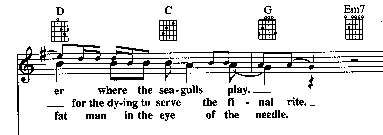Study Guide
Week 1
[ Review ] [ New Material ] [ What You Should Know ] [ Homework ]
Review
If you don't know the notes of the treble and bass clefs then you have to do some study quickly in the next couple of weeks. "Knowing" them means that you can instantly identify any note on the treble or bass clef. Taking a few seconds or more to figure it out is not satisfactory and will inhibit your understanding, and therefore your progress, through this and future courses.
You can print out our flashcards or make your own. Study three facts at a time for a few minutes, preferably a couple of times a day. Review what you've studied on successive days in order to make the information quickly available from your long term memory.
It is assumed from the prerequisites of the course that you know how to form triads and seventh chords and what their corresponding chord symbols are. You will need to understand how Roman numerals are used to represent chord functions. You may need to review the material from the preparatory course for this class.
The last material that you need to know well by memory are key signatures. When asked a question like "What is the key signature for Eb major?" you need to be able to say "Bb, Eb, and Ab." within a few seconds. If you don't know this you will have a hard time forming chords and dealing with harmonization when we get to it.
You should learn this by the end of next week. Study the material in groups of three facts for a few minutes several times a day, reviewing each time what you've done before in order to get it to stick in your memory and be quickly accessible. Do not put this off. Many students fall behind and do poorly later because they haven't mastered this basic material.
New Material
Transposition
This week we learn how to transpose lead sheets for trumpet and any of the four saxophones. You should know the ranges and transpositions of the instruments we cover.
How to notate lyrics
Words are broken into syllables. Hyphenate the words to show which syllable falls underneath which note. A syllable or word that is held out and continued has a wide dash (wider than a hyphen). Look at a well edited song book and see how lyrics are notated, paying attention to hyphenation, dashes, and punctuation.
In the example below, starting in the second measure, the word "All is held out for three notes. Notice the wide dash that goes under the second and third notes. Likewise, "time" starting in the next measure is held for three notes. In the second line "flowed" is held for three notes.
The word "river" is broken into two syllables using a hyphen:
If there are repeats you can show how the melody changes depending on the words. In the following example the main melody, the one used the first time through ("...er where the seagulls play."), is written with larger not heads and with stems going down, even when the note heads are below the third line. The second ("for the dying to serve the final rite") and last time through (fat man in the eye of the needle") have a different number of syllables than the first time through. The note heads for those notes are smaller and written with stems going up:
What You Should Know
At the end of this week you should be able to:
Transpose a lead sheet for a transposing instrument, such as trumpet or one of the saxophones. You should also know the written range of the instruments in order to know which notes are playable.
Notate lyrics on a lead sheet
Homework
See the homework assignment. Like every week, the homework will be due at the Friday of the following week, in other words, NEXT FRIDAY. The homework assignment is summarized on the class schedule, but the assignment page is the final authority and goes into greater detail.
©2002 Robert Willey

